How to pick up anything and everything, without hurting your back
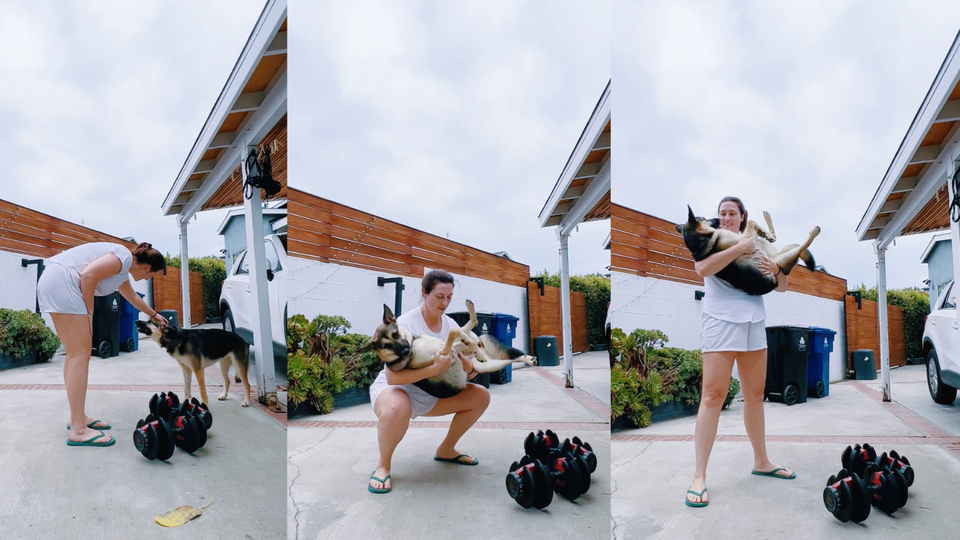
Disclaimer: This post presumes you are an otherwise healthy individual, and is presented for education purposes only. If your back hurts or causes you trouble, see a doctor! Not the internet.
A few weeks ago, a reader sent me an image. And what an image it was. (Just to be clear: The image features a pregnant woman, but it depicts an issue that concerns us all.) Here is her email, and the image:
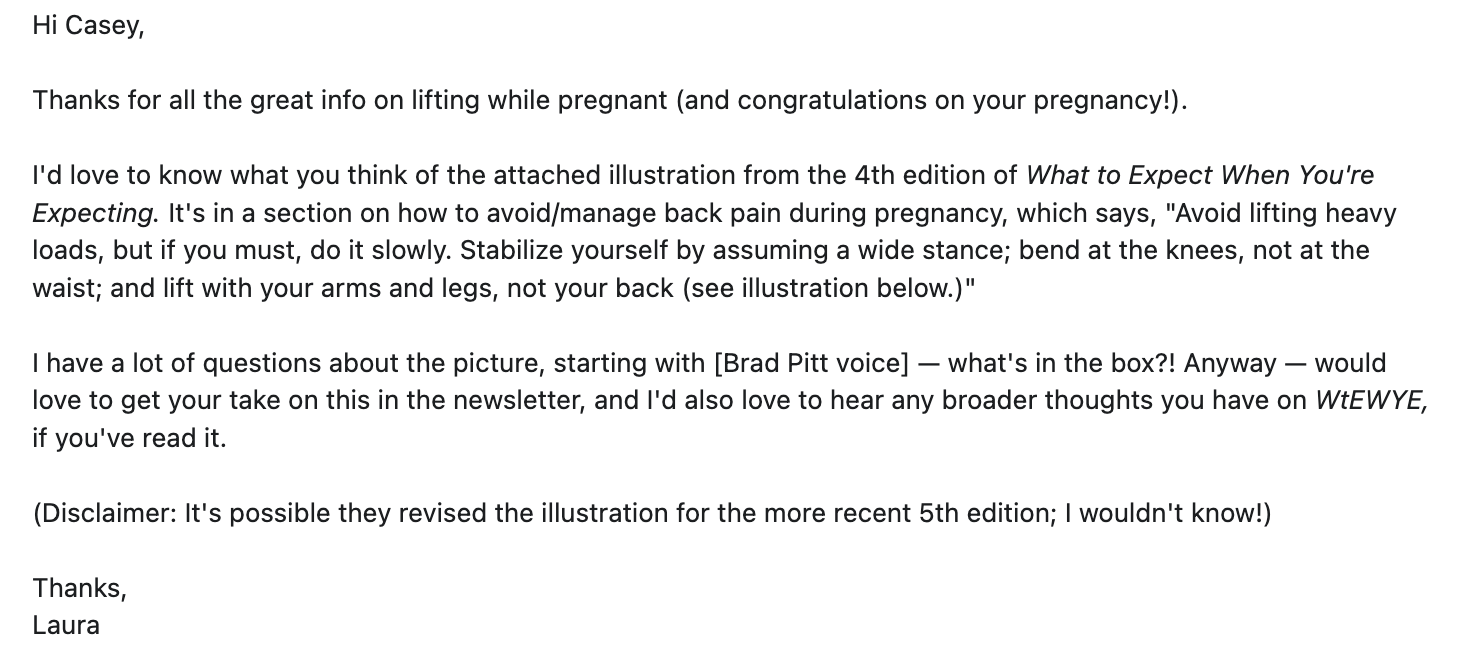
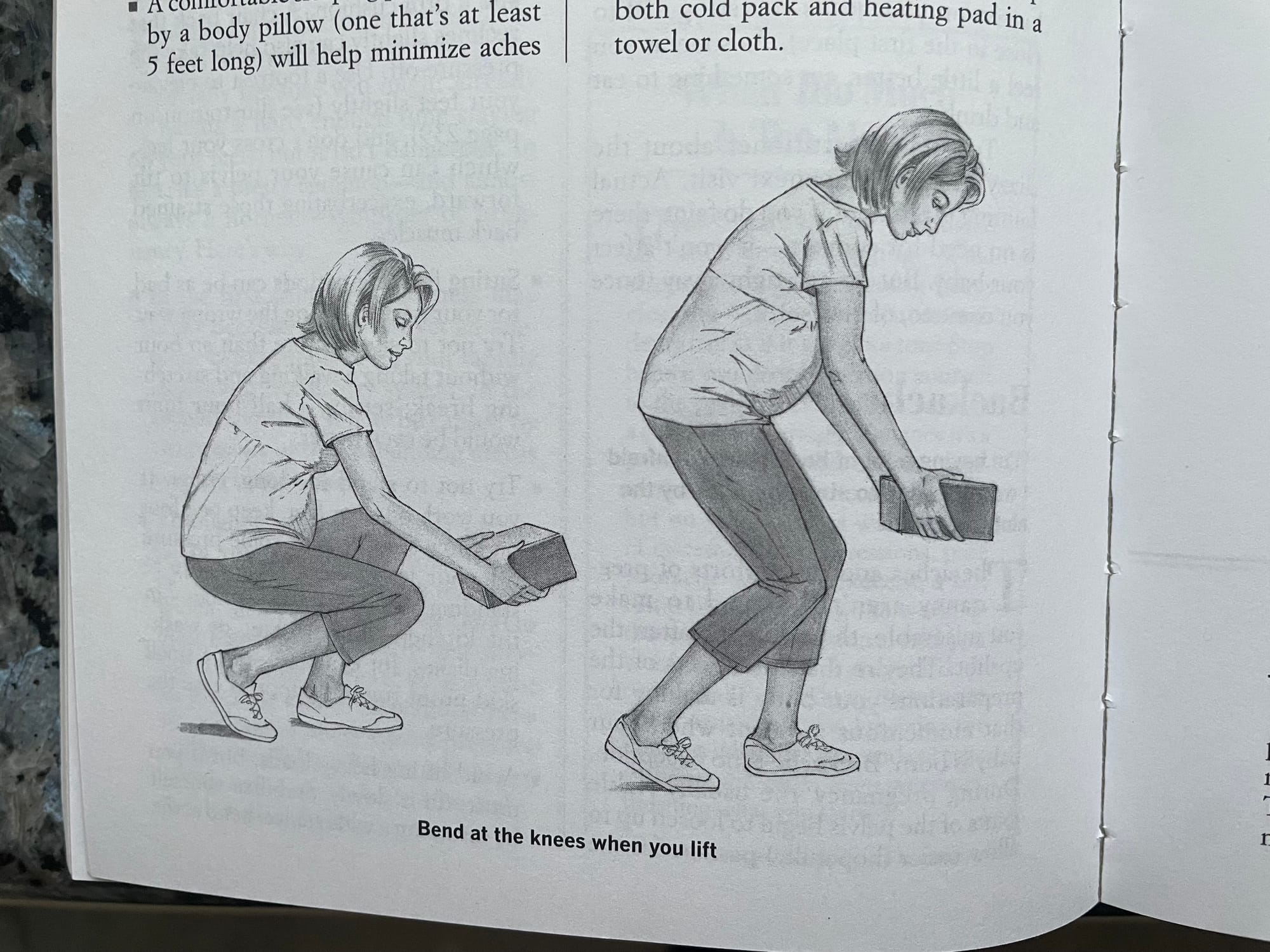
Now, this is the wrong way to pick things up, not just for pregnant women, but for everyone. But let’s table that for a moment. The fourth edition of this book was published in 2008; the fifth edition came out just last year, in 2024. This is a journalistic publication with a duty to its readers, and much has changed in the intervening time with respect to how we view pregnant women and strength. So I purchased this fifth edition in e-book format, and searched the text for “bend at the knees” to see if anything had changed. Lo and behold:
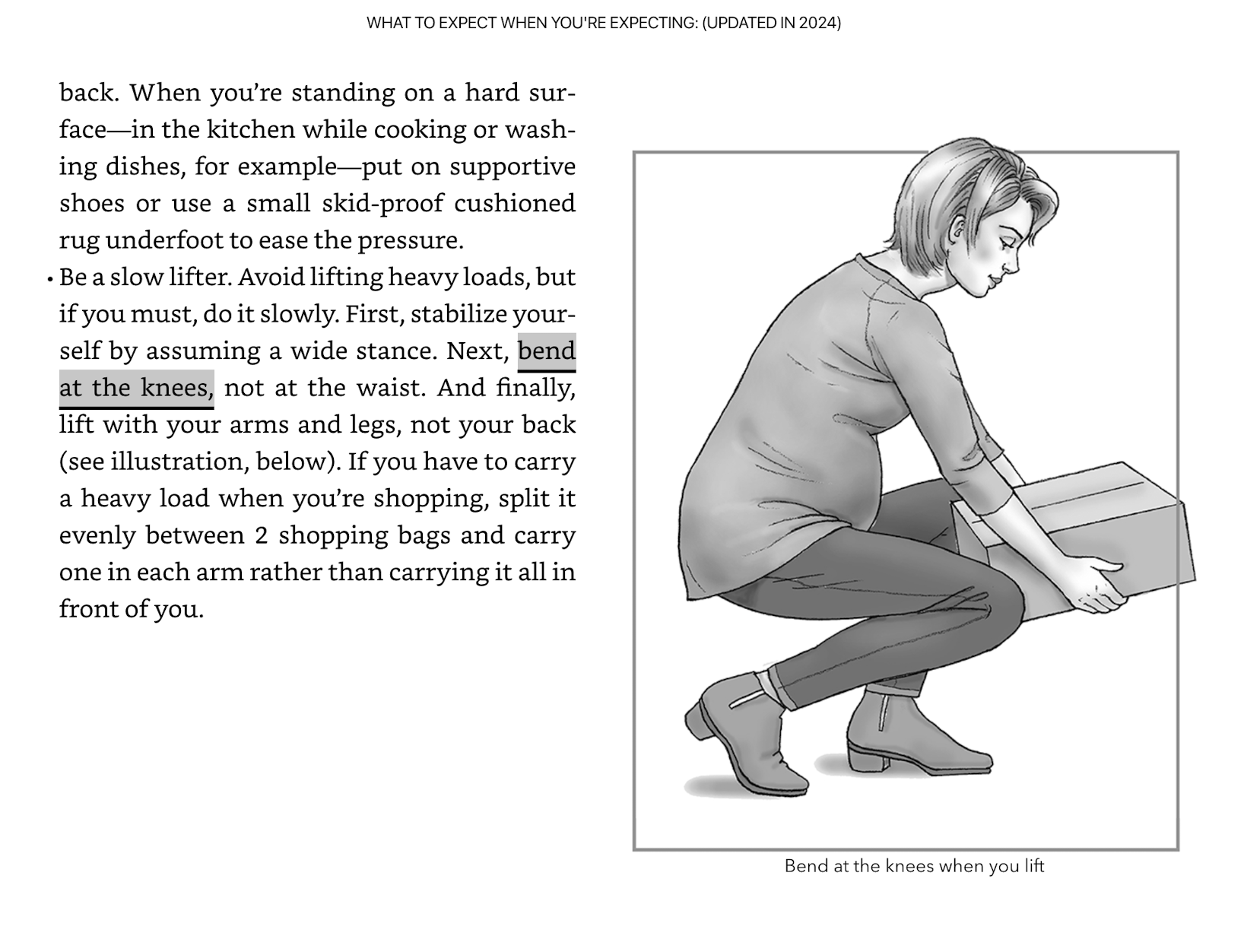
Incredibly, they went to the trouble of rolling a whole new illustration, yet the instructions are still wrong, again, not just for pregnant women, but for everyone. Ah, to laugh! Gaily, I laughed, reader, from the depths of my own pregnant belly.
If I had to boil “why you should lift weights” down to one concise reason, it would probably be “it will teach you to pick stuff up without hurting, straining, pulling, spasming, or otherwise harming your back, especially your lower back.” If I threw a rock at all of my friends standing in a group—something I would never do—I’d hit at least five people who have suddenly found themselves with a debilitating back injury, by doing no more than living their everyday lives. Some of them even became injured not by doing anything in particular, but by not doing enough, i.e. sitting too much. All of them happened when these people were under the age of 35. That’s kind of wild!
The good news is that it doesn’t take a lot of training to be able to pick up some of the heaviest objects you come into contact with in the real world. A little recreational picking-stuff-up can go a long way toward preventing these kinds of bad surprises. A toddler, a big bag of dog food, a heavy box, or a bag of laundry are probably 40 pounds at the outside; even if you start from bodyweight using no extra weight at all, it will not take you longer than a few weeks to progress to deadlifting or squatting 40 pounds. No, I am not pulling your leg. Though I could, very hard, if I wanted to.
So, exactly what lessons does a truly basic, rudimentary knowledge of lifting weights as exercise teach us about picking stuff up in the real world?
One of the most core principles of lifting weights (and this is covered in LIFTOFF) is that the further a weight is from your body, the heavier it is going to feel. Try cradling a weight, even a small one, in your hand next to your body versus holding it out in front of you. This is why beer stein holding competitions are so deceptively difficult.
“Bend at the knees to pick something up” is a common refrain, but it is so incomplete as an instruction that it is almost impossible to make sense of. Before starting to lift, I’d heard this refrain all my life, as well as “lift with your legs, not your back” (which also appears in the What to Expect text).
But neither instruction told me where my legs were supposed to go. Essentially, I had the same confusion as our pregnant friends in the diagrams above. My legs always seemed in the way of the thing I was picking up, if it was in front of me (and it’s usually in front of you).
If I tried to “bend at the knees,” they ended up all akimbo in front of me, between me and the weight, and it didn’t seem to really help with the issue of not using my back. If I tried to bend over more at the waist to get my knees out of the way, I had to keep my legs straighter, which meant I couldn’t really “use” my legs in any meaningful sense, and it became a back lift. For years, I struggled with this problem, and strained my back a lot.
The really annoying thing was that this was always coming up when I was in a fair amount of hurry to pick up whatever the thing was, and it was no time to either experiment or consult those around me for advice. When you are moving boxes and can only afford the truck for a few hours, or are trying to get the big bag of dog food from the shopping cart into the back of the car when it’s 20 degrees out, there is no time for dilly-dally.
But if you are former-me, I’m here to finally solve this puzzle for you.
The steps to picking up anything without hurting your back
- Your knees (and feet) go on either side of the object, such that you are essentially wrapping yourself around the thing, bear-hugging it to the extent possible up and into your torso, until it is as snug as possible to the front of your body. Ideally, you have the flexibility to get low enough that you can hug the thing right to your chest/stomach,[^1] even if it’s relatively low to the ground, while your torso is relatively upright (you don’t want your upper body caved directly over the object).
- You find your balance such that your feet are under you and you are neither going to pitch forward, nor fall backward. (Effectively, by bringing the object as close to yourself as possible and wrapping yourself around it, you are displacing your center of gravity a little towards the object; this math problem is left as an exercise to the reader.)
- Hold tight to whatever the thing is, give your core a little brace, and prepare to keep your back in position by holding tension in the muscles. The item should not be dragging your torso back down as you try to stand up.
- Stand up by extending your legs, pushing the floor away with your feet, and keeping that tension in your back.
That is what it actually means to “bend at the knees” and “use your legs, not your back.”
I would venture that if you can’t pick something up this way, you are actually not strong enough yet to pick it up, period. Especially if you are pregnant, get help, lest you injure yourself, and keep practicing with your training. See here for a video of what I mean:
The original Couch to Barbell site video features this exact process
But why do it this way? I thought backs were strong? Is the problem not my weak noodly arms?
This could be a whole other essay, but in short, no, it's not your literal back or the muscles in it that is meant for acting as a lever or pivot point for moving weight. Your back actually has a relatively small range of motion compared to, say, your hip joint. Mechanically, you want to use the muscles in your back (and the rest of your core) to keep it flat and stabilize your spine. Same for your arms, when picking something up--the kind of strength you want is to be able to hold them statically (we call this "isometric" movements or strength).
Your legs, on the other hand, contain very powerful joints and the largest muscles by volume in your body. Your glutes, which is to say, your butt, are the largest muscles, period. When you move any large thing, you almost certainly want your glutes to be involved. If your glutes tend to resist being involved, it is beyond worth teaching them to follow along with the rest of the class (especially because the work they should be doing gets transferred to the relatively tiny lower-back muscles when they don't, and no one wants that).
Eventually, when you are much stronger, you don't have to be quite so regimented about this form. When you can deadlift 200 pounds, cheating the form to lift 40 pounds will feel like no big deal, like when I pick up my dog, as above.
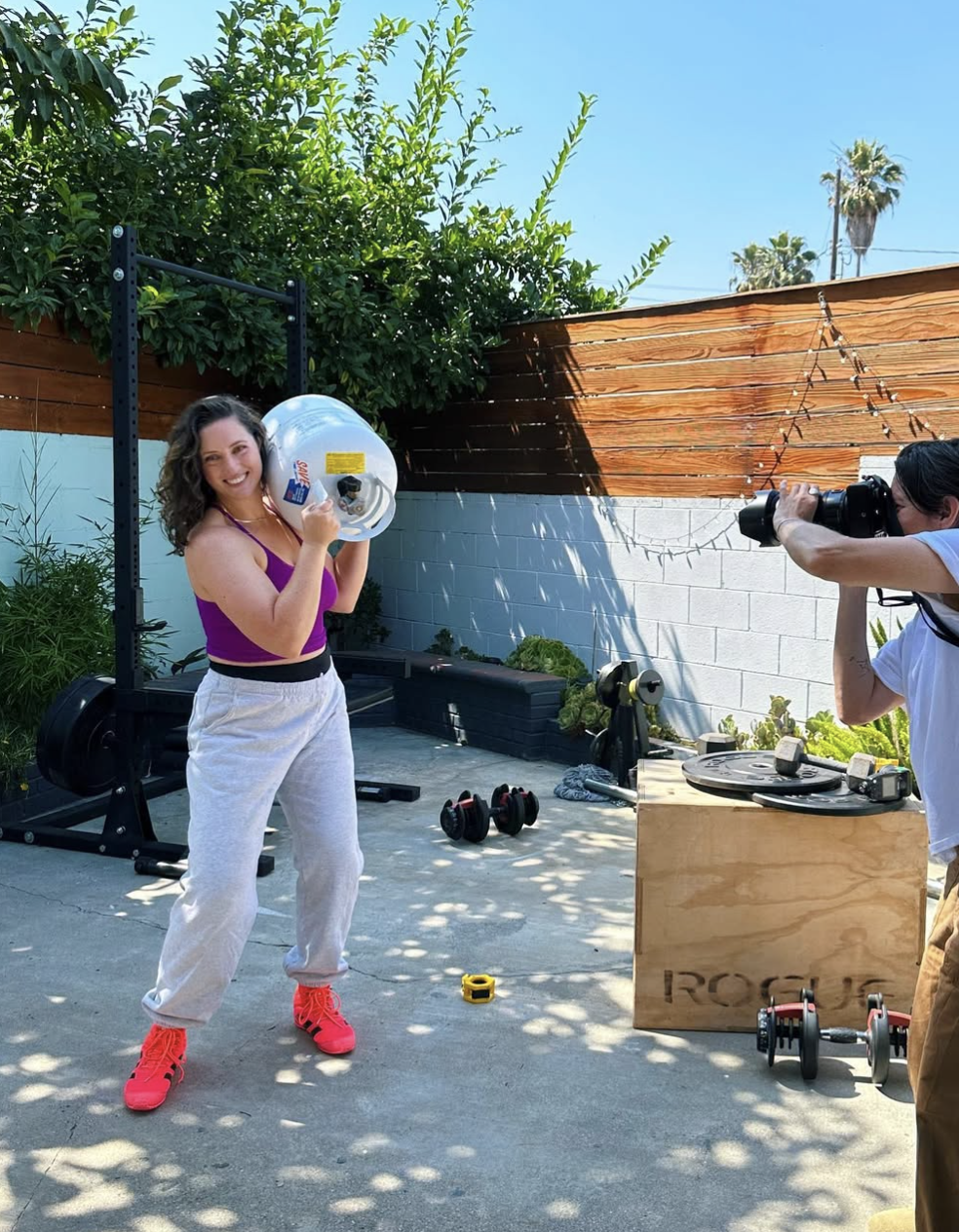
So which lift you are actually doing when you pick something up? It looks like a squat, but seems functionally like a deadlift. Which one should I practice to get good at picking stuff up?
It is true that doing a deadlift is basically fancy “picking something up.” However, in practice, what I just described does look mostly like a squat.
The answer is that this “picking up” action is a little bit of both. Squats and deadlifts are complementary actions and train complementary sets of muscles. But both are also technical lifts and movement patterns, meant to be done with specific types of equipment. Unless the only things you pick up in the real world are barbells lying on the floor, you’re never going to be doing exactly a formal squat or deadlift in the real world.
But! Both movements translate very well to the real world, especially because they are “free weight” movements that help you learn to stabilize yourself, no matter where the force is coming from.[^2] They can also come together and help you do more general movements like standing up from the floor, picking stuff up, crouching down, and pushing and pulling using more than just your arms.
So, sorry, if you want to be good at picking stuff up, don’t cut corners from a basic lifting program. The whole thing is designed to work together, and it all helps. Squats help with being able to position your body low to the ground while keeping your core tight and feet flat on the floor for max stability; deadlifts help with balancing yourself against a weight in front of you, keeping tension in your back, and driving the floor away.
There is slightly more specific training you can do for picking odd objects up. Picking up sandbags is a common Crossfit-type activity, and picking up Atlas Stones is an event in strongman. However, people who perform these activities recreationally or professionally almost always have a solid foundation in the strength-training fundamentals first. This is just to say, if you find yourself in love with figuring out how to pick things up, there’s a wide world out there.
If all the steps sound like a lot to do at once … if doing even one part sounds impossible … that’s okay. Picking stuff up isn’t an innate talent, it’s a skill that can be learned with practice. Many skills are overrated, and I’m a ll for living life how you want and choosing your battles. But to the extent that we all often find ourselves to be just a guy, standing in front of a box/child/big bag of dog food/40-pound package of cat litter, asking it to let us maneuver it into the air for carrying hither and thither—it’s a skill that does come in handy an awful lot.
Sign up to get She's A Beast in your inbox, every week on Friday.
Subscribe here


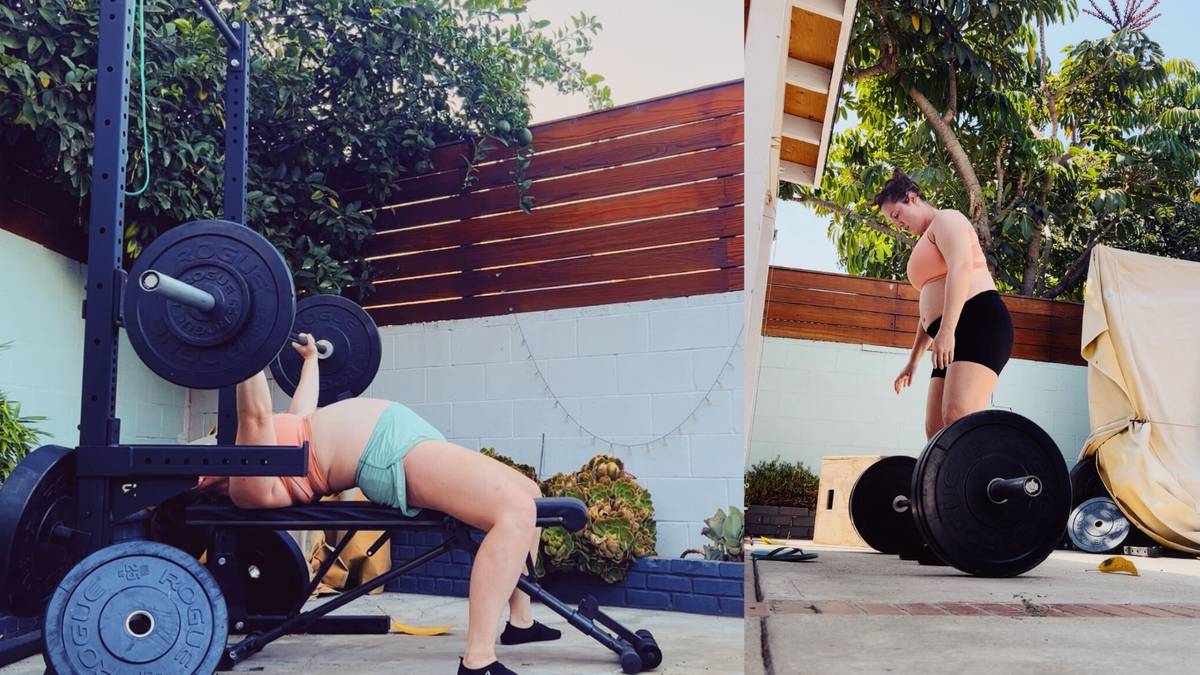
[F1] I suppose the concern of the authors of WTE is that if they tell women to bring an object close to their bodies, it will suggest they should put pressure on their pregnant bellies, and that would be bad for the baby. I don’t pretend to be a doctor, but to the extent these doctors are pretending to know the first damn thing about lifting and revealing themselves to be absolute fools, I have to correct this.
Obviously, do not rest very heavy weights on or against a very pregnant stomach; a pregnant stomach is not a shelf to store objects for later. But it is not better to pick things up holding them away from your body; this carries a risk of injury to the pregnant person. Use judgment and err on the side of caution. The stronger you are going into pregnancy, the less of an issue this will be. Also, going into pregnancy with a strong back and arms will not only help you navigate this extremely common task, but it can help prevent pains that come from carrying around your unborn child, too!
[F2] This is why, all things being equal and with no relevant injury history or disability, the vast majority of people should avoid equipment like Smith machines, which stabilize the weight for you. This takes away a lot of the positive impact of lifting.






Member discussion